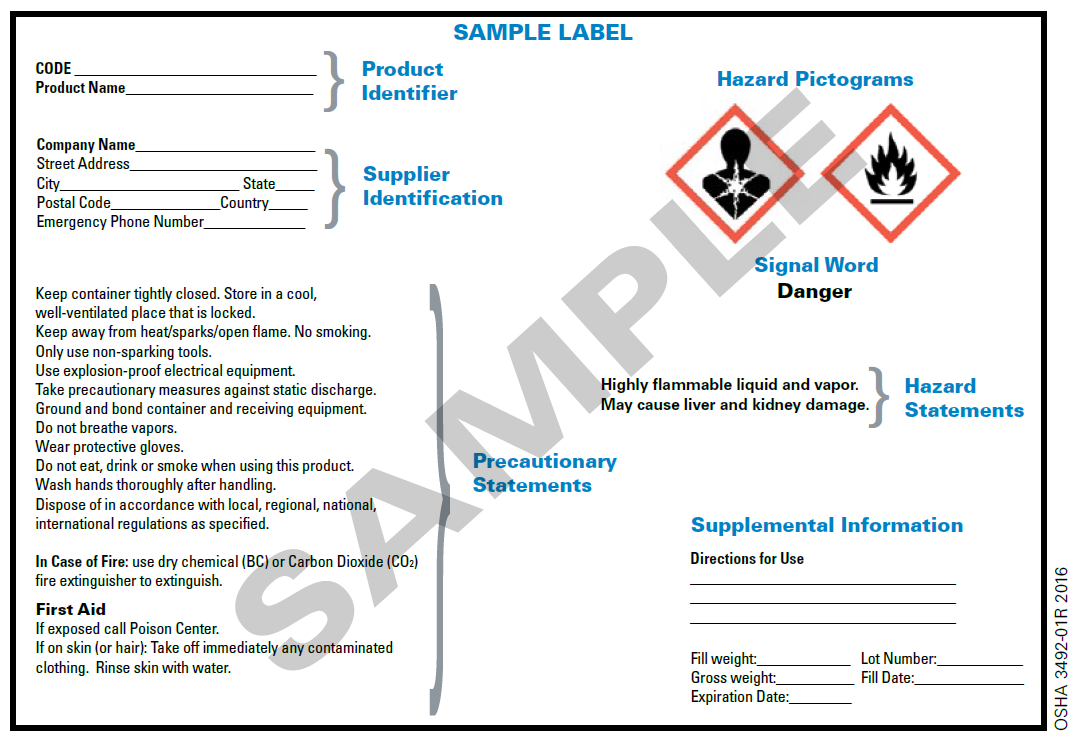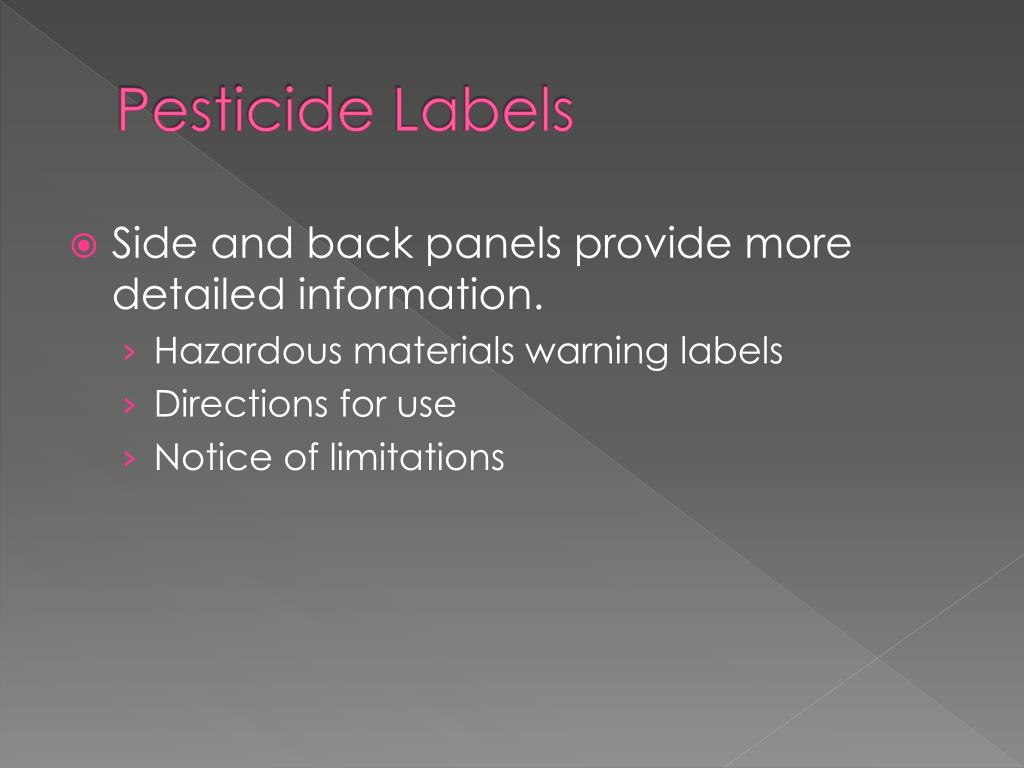41 four types of precautionary statements used on labels
› sites › defaultBRIEF - Occupational Safety and Health Administration category Types C, D, E or F, three of the four precautionary statements for prevention are: • “Keep away from heat/sparks/open flame/hot surfaces. - No Smoking.”; • “Keep/Store away from clothing/…/ combustible materials”; • “Keep only in original container.” These three precautionary statements Precautionary allergen labelling | Food Standards Agency 17.08.2021 · When precautionary allergen labelling should not be used. Precautionary allergen labelling should not be used in combination with a free-from statement for the same allergen. A food cannot carry both labels e.g. “free-from gluten” and “may contain gluten.” PAL should not be used as a substitute for good food hygiene and safety practices.
tobaccocontrol.bmj.com › content › earlyElectronic nicotine delivery systems in Nigeria: product ... Aug 17, 2022 · Electronic nicotine delivery systems (ENDS; e-cigarettes) products are penetrating markets in low/middle-income countries (LMICs) with limited regulations and information on industry activity.1 2 For example, the prevalence of e-cigarette ever-use is estimated at 7.9% among adolescents and young adults in Lagos, the most populous city in Nigeria.3 Although these rates are not as high as ...

Four types of precautionary statements used on labels
User Manual - Hach this equipment. Pay attention to all danger and caution statements. Failure to do so could result in serious injury to the operator or damage to the equipment. Make sure that the protection provided by this equipment is not impaired. Do not use or install this equipment in any manner other than that specified in this manual. 2.2 Use of hazard ... PDF Hazard Communication and The Globally Harmonized System of ... • Precautionary Statements describe recommended measures that should be taken to minimize or prevent adverse effects resulting from exposure to the hazardous chemical or improper storage or handling. There are four types of precautionary statements: prevention (to minimize exposure); response (in case of accidental spillage or exposure ... › system › filesClassifying hazardous chemicals National guide The GHS is a system of consistent information and terms used to classify and communicate chemical hazards on labels and in SDS. The primary aim of the GHS is to protect human health and the environment. It has been developed through co-operation between the United Nations, the International Labour Office (ILO) and the Organisation for Economic Co-
Four types of precautionary statements used on labels. Electronic nicotine delivery systems in Nigeria: product types ... 17.08.2022 · Electronic nicotine delivery systems (ENDS; e-cigarettes) products are penetrating markets in low/middle-income countries (LMICs) with limited regulations and information on industry activity.1 2 For example, the prevalence of e-cigarette ever-use is estimated at 7.9% among adolescents and young adults in Lagos, the most populous city in Nigeria.3 Although … What are the 6 Elements of a GHS Label? - Computype 2. Signal Word. A signal word is used to notify the severity of the hazard. There are only two words that might hold this place on the label: "Danger" (severe hazard) or "Warning" (less severe hazard). Only one word will be on each label, to ensure it is clear to the user the severity of the hazardous chemical. 3. PDF Label Review Manual - Chapter 10: Worker Protection Labeling - US EPA include the signal word, certain Precautionary Statements (Personal Protective Equipment (PPE), ... types on each sub-label. The registrant may market the product under two distinctly different ... There are four types of worker protection statements that generally appear in the Precautionary . Statements of a label. They are as follows: Chapter 18 Flashcards | Quizlet Used to indicate the relative degree of severity of the hazardous chemical and to alert the user to a potential hazard on the label. What information must be included on a hazardous chemical label? Product identifier, supplier identification, GHS signal word, GHS hazard statement, GHS hazard pictograms, precautionary statement.
GHS precautionary statements - Wikipedia P210: Keep away from heat, hot surfaces, sparks, open flames and other ignition sources. No smoking. P211: Do not spray on an open flame or other ignition source. P220: Keep/Store away from clothing/.../combustible materials. P221: Take any precaution to avoid mixing with combustibles. P222: Do not allow contact with air. Identify the four types of precautionary statements used for HazCom labels OSHA's HazCom Standard requires one of eight specific pictograms be included on container labels. For four of the pictograms, provide an example of a chemical that would require its use. Your response must be at least 150 words in length. Explain the differences between product safety labeling and environmental signage. › oshanswers › chemicalsWHMIS 2015 - Safety Data Sheet (SDS) : OSH Answers Sep 03, 2022 · Suppliers and employers must use and follow the WHMIS 2015 requirements for labels and safety data sheets (SDSs) for hazardous products sold, distributed, or imported into Canada. Please refer to the following OSH Answers documents for information about WHMIS 2015: WHMIS 2015 – General; WHMIS 2015 – Pictograms; WHMIS 2015 – Labels › business-guidance › precautionaryPrecautionary allergen labelling | Food Standards Agency Aug 17, 2021 · When precautionary allergen labelling should not be used. Precautionary allergen labelling should not be used in combination with a free-from statement for the same allergen. A food cannot carry both labels e.g. “free-from gluten” and “may contain gluten.” PAL should not be used as a substitute for good food hygiene and safety practices.
Wash. Admin. Code § 296-901-14026 - Appendix C - Allocation of label ... C.2.4 Precautionary statement text. C.2.4.1 There are four types of precautionary statements presented, "prevention," "response," "storage," and "disposal." The core part of the precautionary statement is presented in bold print. This is the text, except as otherwise specified, that must appear on the label. PDF Hazard Communication Safety Program #12-101 There are four types of Precautionary Statements used on labels: Prevention, Response, Storage and Disposal. True 5. The HCS does not apply to consumer products when used in the workplace in the same manner as that of a normal household consumer. True 6. Employers must establish and implement a written hazard communication program. True 7. Classifying hazardous chemicals National guide - Safe Work Australia an umbrella concept used to capture all types of working arrangements or structures. A PCBU can be a: ... hazard statements and precautionary statements to communicate information. The signal words, pictograms, hazard statements and precautionary statements required on labels and SDS are determined based on the chemical’s classification. GHS Label Requirements, Symbols, and Classifications The four types of precautionary statements are: Prevention (ways to minimize exposure) Response (actions to take for first aid, spills, exposures) Storage (methods to safely store the product, incompatible storage conditions) Disposal (safe disposal methods of product and containers containing residual product) Classification and Label Creation
Pesticide Labeling Questions & Answers | US EPA 14.10.2021 · If labels do not specifically state that they can be used in food storage facilities or food processing plants, can these rodenticides be used under 21 CFR 110.35(c), which states in part " The use of insecticides or rodenticides is permitted only under precautions and restrictions that will protect against the contamination of food, food-contact surfaces, and food-packaging …
Appendix C - Occupational Safety and Health Administration C.2.4.1 There are four types of precautionary statements presented, "prevention," "response," "storage," and "disposal." The core part of the precautionary statement is presented in bold print. This is the text, except as otherwise specified, that shall appear on the label. Where additional information is required, it is indicated in plain text.
Chemical Hazard Classification and Labeling: Comparison of OPP ... 5. GHS “hazard statements” are simple statements of hazard, a subset of what OPP calls “precautionary statements.” GHS does not specify any precautionary statements (e.g., first aid, personal protective equipment) beyond hazard statements. There are plans for future work to harmonize additional precautionary language at the international
Precautionary statements in Hazard Communication standard ... Your paraphrased questions and our responses are below. Question 1: When the precautionary statements, "Immediately call a poison center/doctor" and "Call a poison center/doctor/…./if you feel unwell," appears on a label, is it acceptable to only use the more protective statement, "Immediately call a poison center/doctor" per Appendix C.2.4.7?
EOF
How to Use Precautionary Statements Correctly on GHS Labels Some jurisdictions (i.e, US OSHA) also allow precautionary statements to be combined or consolidated to save label space. For example, "Keep away from heat, sparks and open flame," "Store in a well-ventilated place" and "Keep cool" can be combined to read "Keep away from heat, sparks and open flame and store in a cool, well-ventilated place.
GHS Precautionary Statement List - ChemSafetyPro.COM GHS Precautionary Statement List. Little Pro on 2016-01-06 25803. GHS precautionary statement means a standard phrase that describes measures to minimize or prevent adverse effects of a chemical. Each precautionary statement is designated a code, starting with the letter P and followed by 3 digits. P1xx: general precautionary statement;




Post a Comment for "41 four types of precautionary statements used on labels"